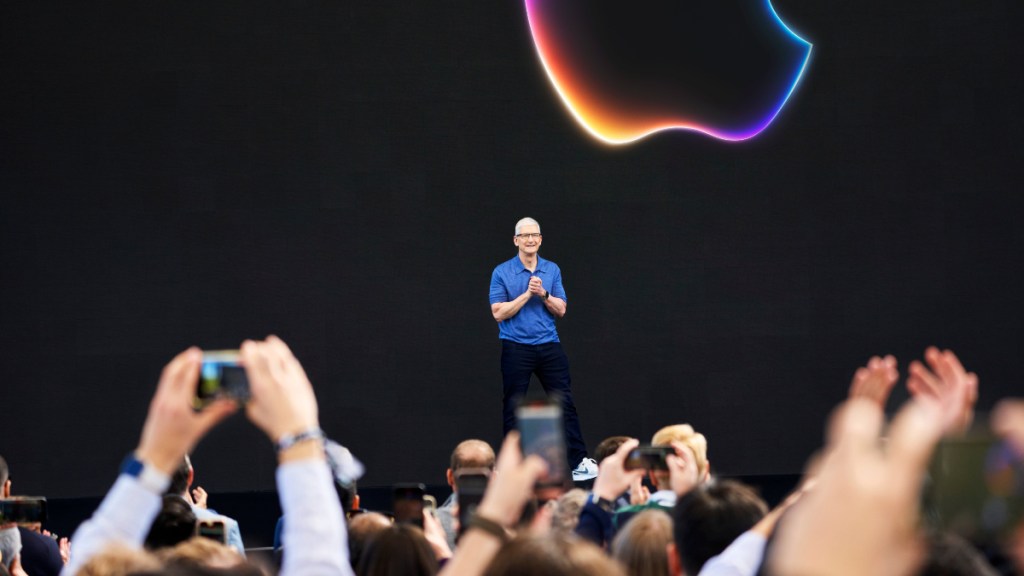Expect Apple to do the unexpected. While every tech company is going gaga over AI, slapping the word on literally every nook and cranny they can find, often times with no rhyme or reason, Apple went the other way round. In an AI heavy WWDC 2024, not once did it say the word AI out loud. Not one executive—there were quite a few who took the stage at the keynote event—budged from the script. As if, it were the great Lord Voldemort himself.
The sense of self awareness has always been high with Apple. It doesn’t like to throw around words just like that. Every move is calculated, not just because it has a great marketing team, but because every move it makes—every word it chooses to use—has far-reaching repercussions. The whole industry waits for these moves, these words, because they have the potential to change the future. You might not always agree with what Apple says or what it does, but you can’t deny that only Apple can pull a crowd—and excitement—around its launch events at a time when almost every other tech event feels bland and boring.
WWDC 2024 was no different. Almost everything we heard on stage was foretold to us in leaks, most of them coming from Bloomberg’s Mark Gurman. But people still cheered at things like calculator coming to iPad with iPadOS 18 or Apple letting iPhone users move around apps and widgets freely on the Home Screen with iOS 18 or macOS Sequoia getting support for iPhone mirroring. Even Samsung was watching the event closely, firing up tweets left, right, and centre giving a running commentary of things as they happened. The tension was palpable.
Apple AI
AI-related announcements had their own separate segment towards the end. The much talked-about ChatGPT integration announcement was saved for the very last. OpenAI’s Sam Altman, while he was present physically at Apple Park, was missing from the keynote footage. Bringing ChatGPT to iPhone and other Apple devices was a seemingly difficult decision.
The deal—which is reported to be worth billions of Dollars—has not been without its share of internal resistance. John Giannandrea, Apple’s head of machine learning, was apparently not in favour of including a large language model-driven chatbot in Apple products. The partnership has also raised concerns at Microsoft with CEO Satya Nadella being wary of the implications for the company’s existing collaboration with OpenAI.
Microsoft has invested a staggering USD 13 billion in OpenAI, securing rights to a share of its profits and the use of its technology in its enterprise and consumer products. The new deal with Apple could potentially strain the relationship, given their overlapping interests in AI. There is the data angle as well. OpenAI has failed to give a proper answer to if at all it has used YouTube videos to train its models. If it has, it is in violation of YouTube’s terms of service, as confirmed by both Alphabet and Google CEO Sundar Pichai and YouTube CEO Neal Mohan.
For what it’s worth, ChatGPT is only a tiny piece of Apple’s AI puzzle. It’s totally optional which is to say, you can choose to not use it, at all. You’re bound by OpenAI’s data-use policies only if you connect your account, else Apple will hide your IP address and OpenAI won’t store your requests, while using ChatGPT on iPhone.
Meet personal intelligence
The bigger picture is the Apple Intelligence. It’s AI but with an Apple twist. (It’s a two on two actually. Last year’s WWDC saw the resurgence of “spatial computing” with the Vision Pro headset.) There are two things to keep in mind—AI is still a touchy subject for privacy advocates and Apple is playing catch up with Google and Microsoft. A catchy name like Apple Intelligence not only generates great buzz and keeps investors interested, it should hopefully keep some of the privacy concerns at bay. But that’s just marketing talk.
The Apple twist extends into the actual product. Apple Intelligence is more personalised and it is built from ground up with privacy in mind. Apple says many of its early AI features—without actually calling them AI features—will work on-device. It has built algorithms to decide when a task can be achieved locally and when it needs to tap into Apple’s cloud severs. In these servers, Apple is using its own silicon—M2 reportedly—to ensure remote data processing remains secure within a Secure Enclave through a system called Private Cloud Compute. While not explicitly confirmed, it will reportedly avoid creating user profiles and will generate reports confirming that user data isn’t being sold or accessed.
“Apple Intelligence is grounded in your personal information and context with the ability to retrieve and analyse the most relevant data from across your apps, as well as to reference the content on your screen, like an email or calendar event you are looking at. Understanding personal context is essential for delivering truly helpful intelligence. But it has to be done right. You should not have to hand over all the details of your life to be warehoused and analysed in someone’s AI cloud. With Apple Intelligence, powerful intelligence goes hand in hand with powerful privacy,” said Craig Federighi, senior vice president (SVP) of software engineering at Apple during the keynote.
As widely reported, Apple’s initial batch of AI features focus on practical use cases like summaries and reply suggestions (you can get the full lowdown here) but Apple is prioritising personal context so responses are more useful and relevant. A big catch however is that not every iPhone, iPad, or Mac with iOS 18, iPadOS 18, or macOS Sequoia, will support them. Apple Intelligence works only with iPhones with the A17 Pro chip (iPhone 15 Pro/iPhone 15 Pro Max) and iPads/Macs with M1 and later. (This is in sharp contrast to Samsung which plans to roll out Galaxy AI suit of AI features to 100 million devices by the end of this year.)
Be that as it may, Tim Cook has called it a “new chapter in Apple innovation” and while it’s too early to judge it—basis of mere paper specs alone—what’s abundantly clear is that for better or worse, Apple has entered the AI race now, and because it’s not calling it AI, it can chart its own course and play the game by its own rules. Others will follow.
Follow FE Tech Bytes on Twitter, Instagram, LinkedIn, Facebook.









